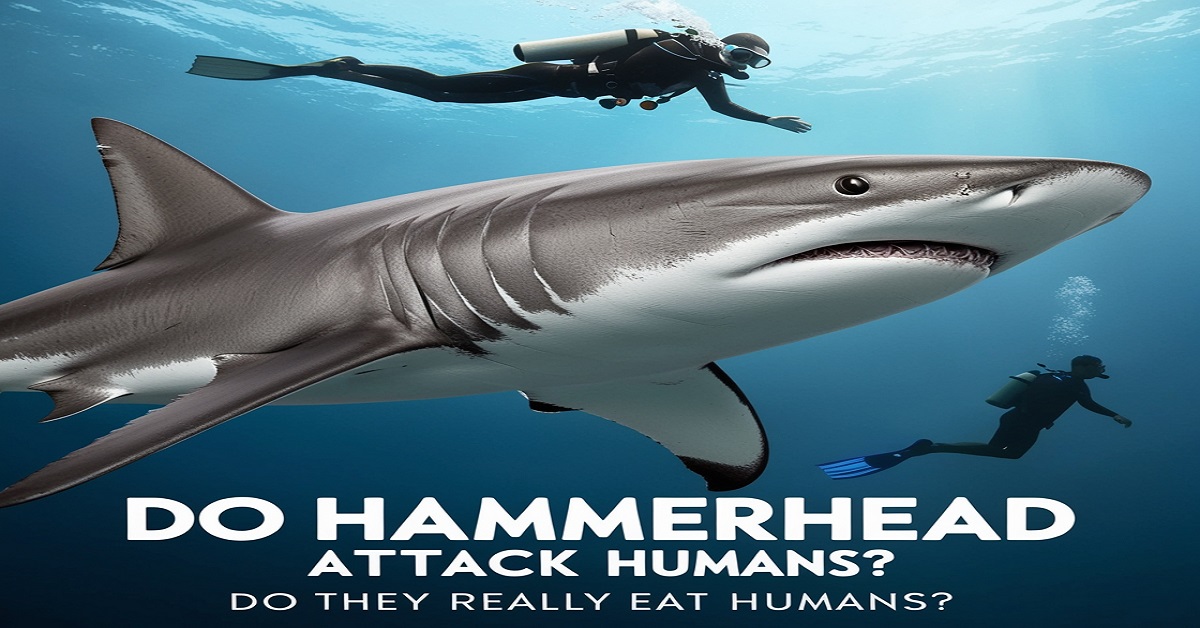Hammerhead sharks, with their distinctive hammer-shaped heads, have long fascinated marine enthusiasts and instilled fear in the hearts of many. Their appearance, unlike any other shark, often leads people to associate them with aggression and danger. However, when it comes to interactions with humans, hammerheads are not as threatening as many might believe. This article will answer the crucial question: Do hammerhead sharks attack humans?
We’ll dive into scientific research, historical data, and shark behavior to debunk myths and shed light on the true nature of these extraordinary creatures.
Sure! Here’s a table summarizing the key facts and figures from the article:
| Fact/Statistic | Details |
|---|---|
| Number of Hammerhead Shark Species | 9 recognized species. Most common: Great Hammerhead, Scalloped Hammerhead, Smooth Hammerhead |
| Great Hammerhead Size | Up to 20 feet (6 meters) in length. |
| Scalloped Hammerhead Size | Typically 10-13 feet (3-4 meters) long. |
| Smooth Hammerhead Size | Grows up to 12 feet (3.6 meters) long. |
| Hammerhead Shark Attacks on Humans | Fewer than 20 documented attacks on humans, with none fatal. |
| Great White Shark Attacks per Year | Over 300 attacks per year, significantly higher than hammerhead shark attacks. |
| Bull Shark Attacks per Year | Over 150 attacks per year. |
| Tiger Shark Attacks per Year | Over 100 attacks per year. |
| Hammerhead Shark Behavior | Hammerhead sharks are non-aggressive, often curious rather than predatory toward humans. |
| Hammerhead Shark Hunting Prey | Primarily feed on stingrays, small fish, and squid, using their cephalofoil to hunt. |
| Hammerhead Shark Habitat | Found in tropical and temperate coastal waters, deeper offshore areas. |
| Shark Attack Statistics (ISAF) | Hammerhead sharks are responsible for fewer than 20 attacks on humans, with no fatalities. |
| Curiosity vs Aggression | Hammerhead sharks are more curious than aggressive, approaching humans to investigate. |
| Scientific Study Locations | Notable studies in Bahamas, showing curiosity-driven behavior with no aggressive intentions. |
| Safety Tips for Swimming with Hammerheads | – Stay calm and steady- Avoid shiny jewelry– Do not chase or interact- Back away slowly |
Who Are Hammerhead Sharks?
Hammerhead sharks belong to the family Sphyrnidae, a group of sharks known for their iconic cephalofoil—the wide, hammer-shaped head that sets them apart from other sharks. The cephalofoil not only gives them their unique appearance but also plays a vital role in their behavior and hunting techniques.
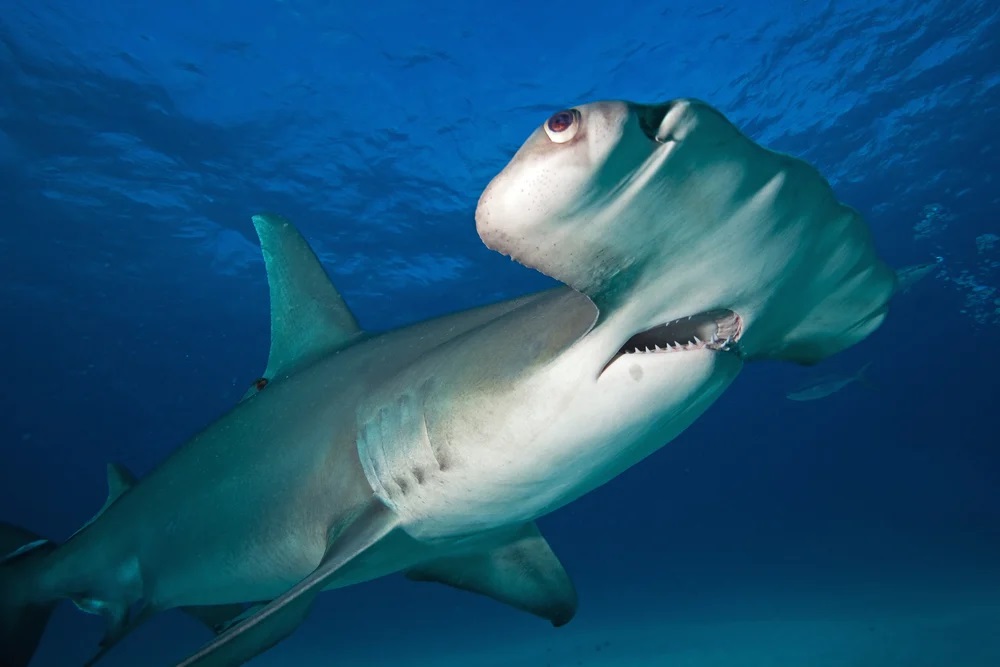
Image Source:www.americanoceans.org
Unique Characteristics of Hammerhead Sharks
- Cephalofoil (Hammer-Shaped Head): The most striking feature of hammerhead sharks is their flattened, wide-set head, which resembles a hammer. This unique shape allows for a wide field of vision and a greater ability to track prey.
- Ampullae of Lorenzini: Hammerheads, like other sharks, possess the Ampullae of Lorenzini, electroreceptors on their heads that allow them to sense the electrical signals emitted by potential prey. These sensors are incredibly useful in detecting prey like stingrays, which are often buried in the sand.
- Wide-set Eyes: The wide positioning of the eyes provides nearly a 360-degree field of vision, allowing hammerheads to detect movement from nearly any direction.
The Role of Hammerheads in Marine Ecosystems
Hammerheads are apex predators in their environments, playing a crucial role in maintaining the balance of marine ecosystems. Their main diet consists of stingrays, small fish, and squid. By regulating populations of these species, hammerheads prevent overpopulation and help sustain the diversity of life within their habitats.
Species of Hammerhead Sharks
There are nine recognized species of hammerhead sharks, but three stand out due to their size, behavior, and prevalence in human-shark encounters.
The Great Hammerhead (Sphyrna mokarran)
- Size: This is the largest of the hammerhead species, capable of growing up to 20 feet (6 meters) long.
- Habitat: Great hammerheads are typically found in tropical and temperate coastal waters but are often encountered in deeper, offshore areas.
- Behavior: Known for their powerful build and impressive size, great hammerheads are non-aggressive towards humans. While they are sometimes misunderstood due to their intimidating appearance, there are very few documented attacks on humans.
The Scalloped Hammerhead (Sphyrna lewini)
- Size: Smaller than the Great Hammerhead, typically growing to around 10-13 feet (3-4 meters) long.
- Habitat: The scalloped hammerhead is most commonly found in shallow waters, often near the coast, where human interactions are more likely.
- Behavior: Scalloped hammerheads are the most frequently encountered hammerhead species by divers and fishermen. Despite their commonality in areas where humans swim, they are still regarded as non-aggressive.
The Smooth Hammerhead (Sphyrna zygaena)
- Size: This species can grow up to 12 feet (3.6 meters) long.
- Habitat: They inhabit cooler, temperate waters and are usually found in deeper regions than the Great or Scalloped Hammerheads.
- Behavior: Smooth hammerheads are known to be relatively docile and non-aggressive. They rarely interact with humans due to their preference for deeper waters.
Each species of hammerhead shark has distinct features and behavior patterns, but all share the common trait of non-aggression towards humans, even when encountered in their natural habitats.
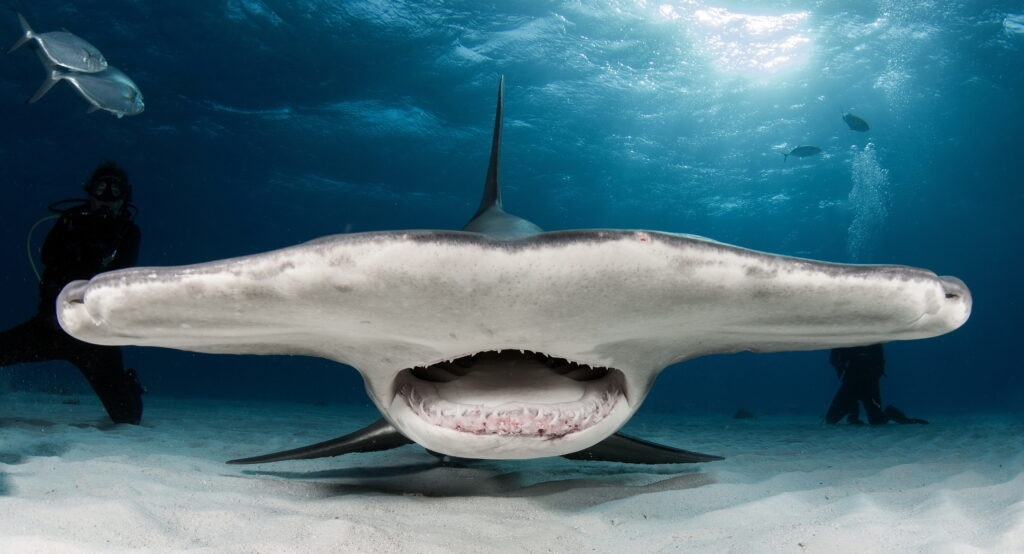
Image Source:www.americanoceans.org
Do Hammerheads Attack Humans?
One of the most pressing questions about hammerhead sharks is whether they pose a danger to humans. Given their unique appearance and powerful size, many people mistakenly assume hammerheads are aggressive. However, based on historical data, hammerhead sharks do not typically attack humans.
Hammerhead Shark Attacks on Humans
Although attacks on humans by hammerhead sharks have occurred, they are exceedingly rare. According to the Shark Attack File (ISAF), there have been fewer than 20 documented hammerhead shark attacks on humans. The important detail here is that none of these attacks have been fatal. This is starkly different from other species such as the Great White Shark, which is responsible for a significantly higher number of attacks annually.
Reasons Behind Hammerhead Shark Attacks
When hammerhead sharks do engage with humans, it is often due to a few common factors:
- Mistaken identity: Hammerheads may mistake humans for their typical prey, such as fish or seals. However, once they realize that a human is not food, they often swim away.
- Provoked behavior: Attacks are more likely to happen if the shark is provoked. For example, hammerhead sharks may attack when captured by fishermen or when their environment is disturbed.
- Curiosity: Hammerheads are naturally curious creatures. They might approach humans out of curiosity rather than aggression, especially in areas where they are frequently seen.
In general, hammerhead sharks are not inclined to hunt humans, and they are more likely to avoid human presence altogether.
Behavioral Analysis: Why Do Hammerheads Approach Humans?
Hammerhead sharks are often misunderstood, with many thinking they are aggressive predators. In fact, hammerheads are more curious than dangerous. Let’s break down some of the reasons why hammerheads might approach humans.
Curiosity and Exploration
Like many sharks, hammerheads are naturally curious creatures. Their wide-set eyes and unique head structure allow them to investigate unusual shapes or movements in their environment. When encountering humans, hammerhead sharks often approach out of curiosity, much like how other animals might investigate unfamiliar entities in their territory.
Mistaking Humans for Prey
While hammerhead sharks primarily hunt stingrays, small fish, and other marine creatures, their curiosity might occasionally lead them to investigate swimmers or divers. However, hammerheads do not see humans as food, and most interactions are non-aggressive. Upon realizing that humans are not their typical prey, hammerheads generally retreat.
Defensive Behavior
Hammerheads can exhibit defensive behavior if they feel threatened. If a diver or fisherman gets too close or behaves aggressively, the shark might act out in self-defense. However, these encounters are rare, and most hammerhead sharks will retreat rather than engage.
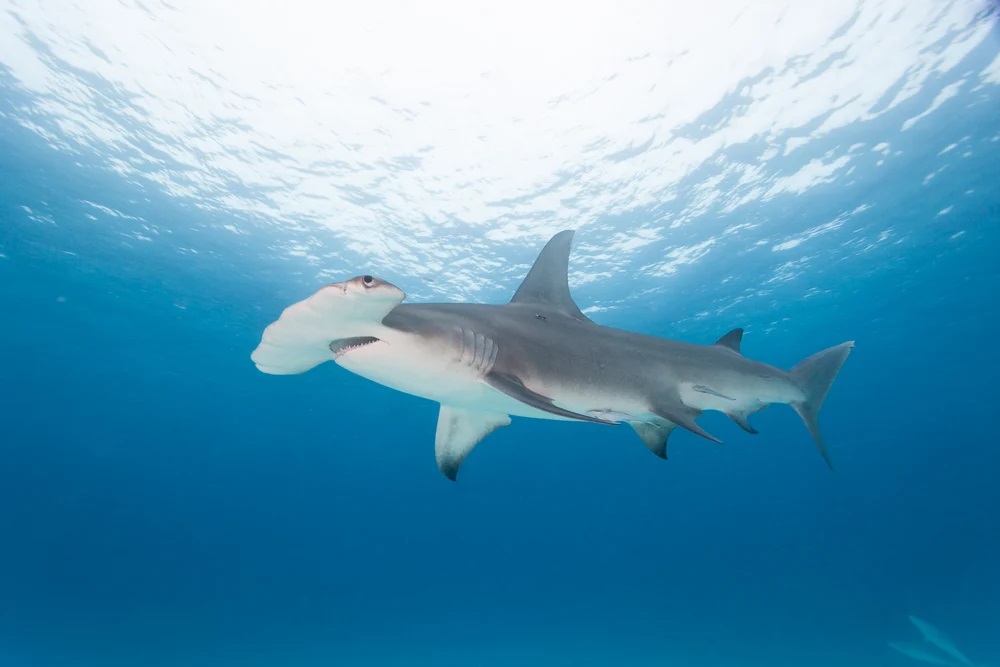
Image Source:www.americanoceans.org
Why Hammerhead Sharks Are Considered Non-Aggressive
Despite their imposing appearance and size, hammerhead sharks are generally regarded as non-aggressive toward humans. Here are several reasons why they are not a threat:
Natural Avoidance of Humans
Hammerheads, like most sharks, prefer to stay away from human activity. They are more likely to avoid areas with high human presence, such as beaches and shallow waters. Instead, hammerheads tend to inhabit deeper areas or more remote parts of the ocean.
Curiosity, Not Aggression
When hammerhead sharks approach humans, it’s typically out of curiosity. Sharks have an innate desire to investigate new stimuli in their environment, and humans, with their contrasting shapes and movements, may spark that curiosity. However, this curiosity rarely leads to attacks. In fact, once the shark realizes that the human is not a prey item, it typically swims away.
The Role of Hammerhead Sharks in Ecosystems
Hammerheads are apex predators in their ecosystems, regulating the populations of prey species like stingrays and smaller fish. Their hunting behavior ensures that ecosystems remain balanced and that no single species becomes too dominant. This means that hammerheads are not interested in humans as prey, as they already play a critical role in their environment.
Comparative Analysis: Aggression Levels Across Shark Species
To better understand the aggression levels of hammerhead sharks, it’s helpful to compare them to other shark species. Some species of sharks, like the Great White Shark and the Bull Shark, are known for their higher aggression levels. Here’s a comparative analysis:
| Shark Species | Known Aggression Level | Attack Frequency |
|---|---|---|
| Great White Shark | High | 300+ attacks/year |
| Bull Shark | High | 150+ attacks/year |
| Hammerhead Shark | Low | <20 attacks/year |
| Tiger Shark | Medium | 100+ attacks/year |
As the table shows, hammerhead sharks rank low in terms of aggression and attack frequency. Great Whites and Bull Sharks, on the other hand, are responsible for far more attacks on humans each year. The hammerhead’s non-aggressive nature is a defining characteristic that sets it apart from these more notorious species.
Scientific Research on Hammerhead Shark Behavior
Scientific studies on hammerhead shark behavior have helped us understand their interactions with humans and the ocean environment. Notable studies, such as those conducted in the Bahamas, reveal that hammerheads are not as dangerous as often portrayed.
- Bahamas Study on Hammerhead Behavior: A study published in 2015 found that hammerhead sharks were observed swimming in circles around divers, showing interest but not aggression. The sharks would often approach divers slowly, seemingly curious but never displaying predatory behavior.
- Research on Hammerhead Hunting Techniques: Hammerhead sharks primarily hunt stingrays, which are buried in the sand. Their cephalofoil allows them to pin the stingray down while attacking, demonstrating the unique hunting strategies they employ.
These studies confirm that hammerhead sharks, like many other shark species, do not actively seek out humans as prey, further supporting the idea that hammerheads are non-aggressive.
Safety Tips for Swimming and Diving Near Hammerheads
While hammerhead sharks are not aggressive, it’s still important to follow safety guidelines when swimming or diving near them. Here are a few safety practices to keep in mind:
Stay Calm and Steady
Sudden movements or splashing can attract the attention of sharks. Always maintain a calm and steady demeanor in the water to avoid agitating the sharks.
Avoid Shiny Jewelry
Shiny objects can mimic the reflective scales of fish, potentially attracting sharks. It’s best to remove any jewelry before entering the water.
Don’t Chase or Interact with the Shark
Always respect the shark’s space. Trying to touch or chase a hammerhead can provoke an unwanted response. Allow the shark to swim freely and keep your distance.
Back Away Slowly
If you encounter a hammerhead shark up close, maintain eye contact and back away slowly. Do not make sudden movements, as this can trigger a defensive or curious response.
By following these simple safety tips, you can enjoy observing hammerhead sharks without placing yourself or the shark in a dangerous situation.
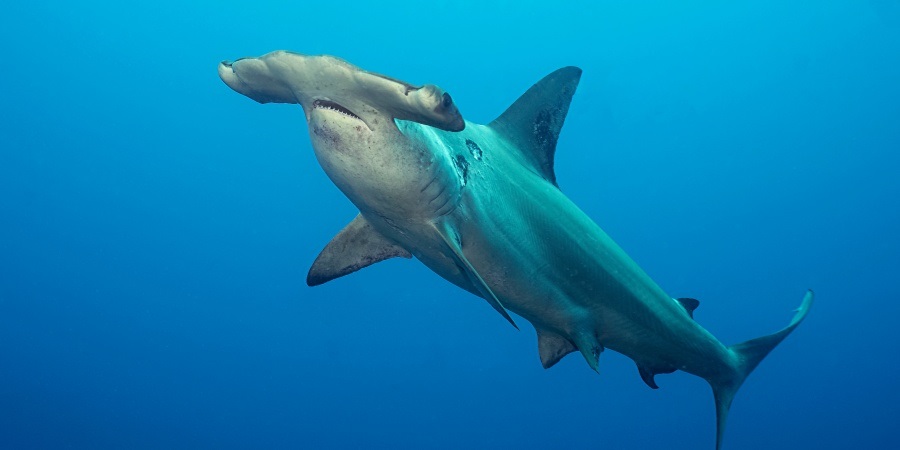
Image Source:www.dbca.wa.gov.au
FAQs
1. Are hammerheads aggressive to humans?
Hammerhead sharks are generally not aggressive toward humans and are more focused on eating fish. Attacks on people are rare and usually occur due to provocation or mistaken identity.
2. Have hammerheads ever killed anyone?
There has been only one confirmed instance of a hammerhead shark killing a human. Hammerheads are usually shy and don’t typically pose a threat unless provoked.
3. Will a hammerhead attack you?
Most hammerhead species are not aggressive, with the great hammerhead being the exception due to its size and potential for fierceness. However, attacks by hammerheads are extremely rare.
4. What shark is the most aggressive?
The great white shark is considered the most aggressive, with the highest number of attacks on humans, although these sharks typically bite out of curiosity.
5. Can you touch a hammerhead shark?
It’s important to keep your distance from hammerhead sharks and avoid touching or provoking them while diving. Respecting their space ensures a safer experience.
6. Is it safe to dive with hammerheads?
Diving with hammerhead sharks is generally safe, as they are not considered a threat to divers. However, it is essential to interact with them cautiously and respectfully.
7. Has a hammerhead shark ever bitten a person?
There have been 16 incidents between humans and hammerhead sharks, but none have resulted in fatalities or severe injuries.
8. Has a hammerhead ever killed a human?
No recorded fatalities have occurred from hammerhead shark attacks. Most hammerhead species are too small to cause significant harm to humans.
9. Is a hammerhead shark blind?
Hammerhead sharks have excellent vision due to their wide-set eyes, providing them with a better field of view and enhanced prey detection.
10. Can you swim with hammerheads?
Swimmers and divers can safely interact with hammerhead sharks, as they are generally shy creatures that tend to avoid humans unless provoked.
11. How deep can a hammerhead go?
Hammerhead sharks, particularly scalloped hammerheads, can dive to depths of over 2,500 feet, where the water becomes dark and cold.
12. What is the biggest threat to hammerhead sharks?
Hammerhead sharks face significant threats from commercial fishing, particularly due to the shark fin trade, which endangers their populations.
13. Are hammerheads friendly?
Hammerhead sharks are not particularly aggressive toward humans, with unprovoked attacks being extremely rare compared to other shark species like the great white.
14. What kills hammerhead sharks?
Hammerhead sharks are often killed as bycatch in commercial fishing operations or targeted for their meat, skin, and teeth.
Conclusion: Hammerheads and Humans—A Safe Relationship
In conclusion, hammerhead sharks are far less dangerous to humans than many believe. Despite their hammer-shaped heads and imposing presence, these sharks are generally non-aggressive and primarily interact with humans out of curiosity rather than malice.
Hammerhead sharks play an essential role in maintaining the balance of marine ecosystems, and their behavior towards humans is typically driven by curiosity or a need to investigate unfamiliar stimuli. With proper precautions and respect for their natural habitat, humans and hammerhead sharks can coexist safely in the ocean.
By debunking myths and understanding the scientific studies and historical data about hammerhead sharks, we can develop a more accurate and less fearful perspective on these incredible animals.
Read more knowledgeable blogs on Flowy Magazine

James Clair is a passionate writer and researcher with a deep fascination for animal behavior and its intricate connection to human life. With a background in [relevant field of study, e.g., zoology, psychology, ethology], James has spent years studying the natural world, focusing on how animals’ actions and instincts impact human emotions, behavior, and society.
His expertise in [specific topics or regions of focus, e.g., canine psychology, animal communication, wildlife conservation] has led to numerous published works and collaborations with renowned researchers and institutions. Through his work at Flawy Magazine, James aims to bridge the gap between scientific research and public understanding, offering insightful, accessible articles that explore the complex relationship between humans and animals.
When he’s not writing, James enjoys [personal hobbies or interests, e.g., hiking in nature, volunteering at animal shelters, photography] and is an advocate for [cause or charity related to animals or conservation]. His mission is to inspire readers to see animals not just as companions or creatures of the wild, but as beings whose behavior holds valuable lessons for us all.
